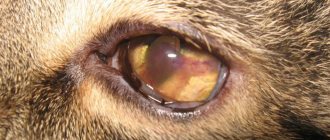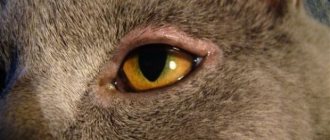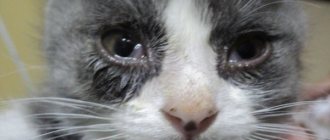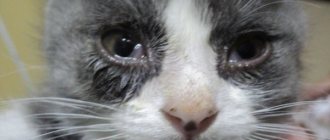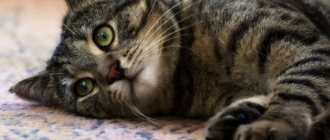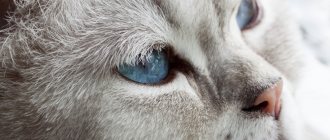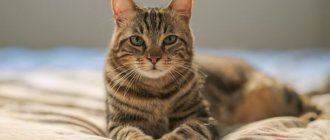8362Pavel
1
Unfortunately, cat breeders, even the most experienced of them, periodically face the negative consequences of communicating with their pets. Let's consider the question of what to do if a cat scratches its eye. In case of unforeseen consequences of the behavior of a domestic predator, it is very important to know the sequence of correct actions in a given situation. The principle of action is almost the same regardless of who is injured - an adult, a child or a recently acquired puppy.
We will not delve too deeply into the reasons for this behavior of a pet or pet. Perhaps the animal was just acting out, perhaps the question is that the aggression was shown by a cat - a mother instinctively protecting her kittens, or a sick animal, which now, perhaps even accidentally, was hurt during medical procedures.
© shutterstock
First signs of injury
One way or another, the fact remains that the eye is injured and it is absolutely unacceptable to take this lightly, especially if the cat scratched the child’s eye. With such an injury, the cornea of the eye is the first to suffer. Despite the fact that a cat scratch on the cornea is not as dangerous as, for example, a burn or penetrating injury (although, unfortunately, sharp cat claws can cause such severe injury), it should never be ignored. A scratch in the corner of the eye, however, as in any other place on the cornea, causes severe discomfort, although it has virtually no effect on vision.
How to treat eye injuries in a cat
First you need to rinse the eye that was damaged. For this purpose, it is necessary to use a solution of furatsilin or boiled water. In addition, eye drops can be used in small volumes for eye injuries, such as Bars, Normax, Tobrex and Tsipromed. The dosage is selected depending on the weight of the animal. The frequency of instillation is no more than 3-5 times a day.
It is undesirable to use Albucid, because this drug irritates the mucous membranes of the eye. The use of corticosteroids is prohibited.
At the veterinary clinic, the doctor will assess the severity and nature of the damage and check for the presence of cranial and jaw deformities. If there are no other injuries, the doctor sends the pet for diagnostics. Only after diagnostic measures the doctor selects the optimal therapy.
How to use eye drops for damaged eyes
To begin with, all scales must be removed from the eyelid. It is recommended to soften them in advance using Vaseline-based compounds. During the day, the eyelids must be treated with syntomycin ointment. For therapy, you can use 1% mercury yellow or tetracycline emulsions. The duration of treatment is no more than 10 days, depending on the severity of the injury.
If a cat has ulcers on its body caused by blepharitis, therapy is based on careful application of lapis. After this, the eyeball is washed with a solution of salt and water.
If small debris, sand or dust gets into the cat's eye, then instead of drops it is better to use calendula tincture or green tea. Surgery is indicated only in severe cases.
What to do if there is suppuration at the wound site
If a cat's eye is purulent, this is a consequence of infection. In such a situation, treatment is carried out with an antibiotic-based solution (Streptocide). The medication is diluted with water, drawn into a measuring syringe and poured into the animal’s oral cavity. The dosage is selected depending on the body weight of the pet.
Help with serious bleeding
If the injury is accompanied by heavy bleeding, then napkins or gauze should be applied to the affected area. To stop bleeding, the dressing should be moistened with a decoction of oak bark, chamomile, or a solution of iodoform or alum.
How to treat a cat's eye after a fight
If an animal has damaged its eyeball as a result of a conflict with other representatives of the cat family, then the damage can be washed out with Diamond eye drops. This remedy is used to eliminate dried secretions in the corners of the eye sockets, with excessive tearing, inflammation of the mucous membrane and redness. The medication must be instilled 1-2 drops no more than 3 times a day.
To avoid additional problems, you need to prevent the animal from scratching the damaged areas. To do this, you need to put a special plastic collar on it. Such products are sold in any pet stores or veterinary clinics.
If a cat has an eye injury, treatment at home should not only be timely, but also correct. To minimize the risk of complications, it is better to seek help from a veterinarian.
All information posted on the site is provided in accordance with the User Agreement and is not a direct instruction to action. We strongly recommend that before using any product, you must obtain a face-to-face consultation at an accredited veterinary clinic.
Symptoms of a scratched cornea
If an animal accidentally or intentionally scratches your or your child's eye, the following symptoms will be present::
- Palpable pain that increases when opening or closing the eyelid
- Blurred vision
- Tearing
- Reddened cornea
- Photosensitivity
In some cases, a headache may occur after a cat scratches an eye.
© shutterstock
Eye injury - symptoms and treatment
The diagnosis is established based on the patient’s complaints, history of injury (history of its occurrence), physical, instrumental and, if hospitalization is necessary, laboratory examination.
History taking and examination
Collection of complaints and medical history is the first, most significant stage in the diagnosis of eye injury. During the interview, it is important to tell the doctor when and under what circumstances the injury occurred, from what object and along what trajectory it moved.
Before interviewing and examining the victim in a calm environment, the doctor should drop anesthetic drops into his eyes [6][7].
After a carefully collected history, the ophthalmologist examines both eyes, and not just the injured one:
- first examines them in daylight;
- then, using a slit lamp, performs biomicroscopy of the cornea of the anterior chamber of the eye, lens and vitreous body.
The surface of the cornea is stained with fluorescein, and a Schirmer test is also performed: the end of a special paper strip is placed behind the edge of the lower eyelid to measure the volume of tear fluid.
Before biomicroscopy, the doctor must dilate the pupil using mydriatic drops. When examining the injured lens, it is important to note whether there are fusions with the scar of the cornea and iris, and to assess the condition of the anterior chamber of the eye. If the transparency of the lens allows, then you also need to carefully examine the posterior chamber of the eye and the anterior layers of the vitreous [6][7]. If there is a suspicion that a foreign body remains in the angle of the anterior chamber of the eye, as well as in secondary glaucoma, it is important to examine the entire angle of the chamber using a gonioscope and a slit lamp, not limited to the suspicious area [6][7].
During ophthalmoscopy - examination of the vitreous body and fundus of the eye - the condition of the optic nerve head and macula is assessed for any defects, edema, detachment, the presence of a foreign body, infiltrates, hemorrhages and shvarts (dense strands of connective tissue similar to adhesions) [6] [7].
It is also important to examine the basic functions of the eyes : their mobility and position in the orbit, visual acuity and field, refraction and intraocular pressure.
Visual acuity is checked using tables, field of vision - at the ophthalmological perimeter, refraction - using a refractometer, intraocular pressure - in a non-contact way, by palpation (feeling the eyes) or with A. N. Maklakov’s tonometer. In case of strabismus, the nature of the pathology and the magnitude of the angle are determined.
If visual acuity cannot be assessed, doctors check whether the victim can correctly determine the projection of light. Patients with abnormal projections should be further evaluated with radiography [1][6][7].
If the visual acuity of the affected eye is high (0.3 or higher), it is important to determine whether both eyes equally perceive the clarity and size of surrounding objects. If necessary, correct strabismus.
biometry of both eyes and echography of the anterior part of the injured eye are mandatory
Additional examinations
- Optical coherence tomography (OCT) and fluorescein angiography of the eye (FA) - allow you to identify damage to the retina, optic nerve and choroid, help determine treatment tactics and decide whether the patient needs laser coagulation of the retina, find a foreign body, clarify its depth and influence on the retina and choroid, monitor the course of the disease and the effectiveness of treatment [1][6][7].
- Electrophysiological examination (EPS) of the eye and electroretinography help determine the severity of the injury, as it reveals gross changes in the layers of the retina and optic nerve fibers. They can also be used to predict the course of the disease and its outcome [1][5][6][7].
- X-ray of the eye . If metal or dense rubber gets in contact, it is advisable to do a survey radiography in two projections, and to detect glass, stone and other low-contrast fragments - a survey non-skeletal radiography.
- Computed or magnetic resonance imaging (CT or MRI) - are performed to clarify the location of a foreign body located close to the wall or inside the membrane of the eye. MRI is preferable, as it does not carry an x-ray load [1][5][6][7].
- Ultrasound examination (US) and ultrasonic biomicroscopy (UZBM) - allow you to obtain additional information about the condition of the eye and its refractive media.
For a comprehensive general clinical examination, patients are examined:
- a therapist or pediatrician to assess the general condition of the body;
- an anesthesiologist if surgery is necessary;
- a dentist or maxillofacial surgeon for damage to the orbit;
- an otolaryngologist if the ENT organs are damaged;
- neurologist for optic nerve injury;
- a neurosurgeon if there is a suspicion of traumatic brain injury.
It is advisable that the ophthalmologist perform preliminary surgical treatment together with a neurosurgeon, maxillofacial surgeon and traumatologist. This will help avoid additional surgical and psychological trauma [1][5][6][7].
Corneal erosions
When the integrity of the corneal epithelium is damaged as a result of mechanical damage (foreign bodies), as well as chemical or toxic effects, corneal erosions occur. In addition, the cause of erosion can be edematous, inflammatory and degenerative changes in the cornea.
For corneal erosions, a characteristic feature is corneal syndrome, accompanied by photophobia, lacrimation, blepharospasm, and pericorneal injection of the conjunctiva. Examination of the cornea reveals an epithelial defect, the size of which is determined after instillation of a fluorescein solution. If the wound does not become infected, then such a defect quickly epithelializes.
Therapeutic activities are carried out on an outpatient basis. To reduce pain, anesthetic solutions are instilled - dicaine, lidocaine or oxybuprocaine (Inocaine). Prevention of inflammation is carried out with antibacterial drugs: a solution of chloramphenicol or sodium sulfacyl.
To activate reparative processes, use a solution of emoxypine, Korneregel ointment, Solcoseryl eye gel or Actovegin eye gel.
Lack of treatment for corneal erosion can lead to the development of post-traumatic keratitis and its transition to the form of a creeping ulcer.
Cat claw injury
The most serious eye injuries are those caused by a cat's claw. Typically, such wounds contain a lot of bacteria and viruses, especially if the injury was caused by a stray cat.
This type of damage is distinguished by a small entrance hole and very large damage inside the eye. Often the animal's lens itself is damaged. In this case, a traumatic cataract forms, requiring surgical intervention. Therefore, it is very important to contact the clinic as soon as possible!
Antibiotic drops or eye moisturizers will definitely not harm your pet in such situations. But no matter how insignificant the injury may seem to you, its consequences can only be assessed through an ophthalmological examination.
The animal needs to be calmed down
Remember that the best sedative is kind, comforting words spoken by the owner in a gentle and calm tone. Panic and screaming, on the contrary, will make the cat even more anxious. In addition, you can give your pet a little sedative, for example, “Cat Bayun”. When the animal has calmed down, you can wash the fresh scratches with a solution of hydrogen peroxide and wipe the wounds with a gauze pad that needs to be soaked in brilliant green. Algorithm for treating wounds.
In case of any, even the most minor injury, the wound still needs to be treated with antimicrobial drugs. We propose to do this using the following algorithm. After the bleeding has stopped, carefully trim the hair that surrounds the damaged area. If there are foreign objects in it (sand, grass, pieces of glass), they must be removed with tweezers. Next, we treat the wound with three percent peroxide or a weak solution of potassium permanganate in order to eliminate bacterial flora and remaining dirt. We recommend disinfecting the skin around the wound with a solution of brilliant green, alcohol or iodine.
This is followed by treatment of the damage with “Sanatol” or “Streptocide”. If you see a deep defect, then you first need to stop the bleeding, treat everything according to the above method and then apply a sterile bandage to the wound, the edges of which are fixed with a regular adhesive plaster.
So, how to provide first aid to a cat in case of various injuries?
To begin the “treatment”, the pet must first be caught, since after the fight he is extremely excited and behaves aggressively. A better option may be to throw a blanket or soft cloth over the cat to prevent it from scratching your hands and face. After twisting, he will stop resisting, and you can begin providing first aid.
Sometimes a cat just needs first aid after a “showdown” with his relatives
Help with serious bleeding
In case of bleeding from the neck or torso, it is necessary to apply a thick layer of gauze or napkins, or absorbent cotton wool and bandage tightly. In order to speed up the stop of bleeding, proceed as follows: moisten the dressing in a decoction of chamomile, or oak bark, in a solution of alum or in iodoform. Collagen sponge is considered the most effective hemostatic material.
Sometimes an animal gets seriously injured in a fight. Then you can’t do without the help of a veterinarian
Our doctors who will solve your vision problems:
Fomenko Natalia Ivanovna
Chief physician of the clinic, ophthalmologist of the highest category, ophthalmic surgeon. Surgical treatment of cataracts, glaucoma and other eye diseases.
Yakovleva Yulia Valerievna Refractive surgeon, specialist in laser vision correction (LASIK, Femto-LASIK) for myopia, farsightedness and astigmatism.
You can find out the cost of a particular procedure or make an appointment at the Moscow Eye Clinic by calling in Moscow 8 (499) 322-36-36 (daily from 9:00 to 21:00) or using the ONLINE REGISTRATION FORM.
